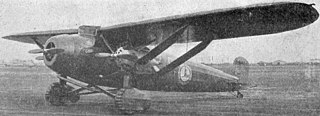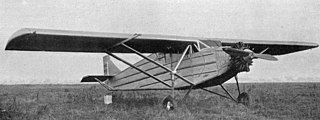Related Research Articles
The Latécoère 14 and Latécoère 16 were similar French passenger and postal aircraft of advanced design built in 1923. They differed chiefly in engine power. Only one of each was constructed. The 14's type number was reused for an unrelated parasol wing prototype that was basis of the more successful Latécoère 17.

The Potez VIII was a French training aircraft which first flew in 1920. Originally it had a very unusual vertical inline engine and a four-wheeled undercarriage, though the production version was more conventional.

The Caudron Type D was a French pre-World War I single seat, twin-boom tractor biplane, a close but slightly smaller relative of the two seat Caudron Type C. More than a dozen were completed, one exported to the United Kingdom, where they may also have been licence built, and three to China.

The Delanne 11 was a French two seat touring aircraft. Only one was built.

The Heinkel HD 20 was a twin engine, three seat German biplane built in 1926 for civil survey work.
The Buscaylet-de Monge 7-4 was a small, French, twin-boom aircraft without a fuselage, built in the mid-1920s to explore the characteristics of a proposed larger machine.
The Peitz 101, aka Peitz Avionette, was a French, amateur-built, all-metal light aircraft, first flown during the winter of 1931–32.
The Renard R.33 was a Belgian training aircraft with aerobatic capability. Two were flown in 1934 but no more were produced.

The Emsco B-2 Challenger was a US three-engined, six passenger aircraft flown in 1929. Only two were built and they were quite soon converted into two different Emsco types, one with one engine and the other with two.

The VIH Holland H.1 was a Dutch two seat, low-powered biplane. Only one was built.

The SABCA Demonty-Poncelet monoplane, Demonty-Poncelet limousine or SABCA-DP was a Belgian light aircraft first flown in 1924. It had two comfortable side-by side seats in a glazed cabin. Though it had competition successes in 1924 and 1925, it did not go into production.
The Peyret-le Prieur seaplane was a low power, two seat biplane floatplane trainer flown in France in 1924. It did not reach production.

The Magni PM.2 Vittoria was an Italian experimental, single seat, parasol wing aircraft built in the mid-1920s. It had a large area aerofoil on each of its single wing bracing struts which could be rotated together or independently to give lift or drag.

The Aviaméta 92 was a French, all-metal, five seat monoplane built in the late 1920s. Three different engines were fitted, and one example flew the first non-stop Paris-Algiers flight in preparation for an abandoned trans-Atlantic attempt.

The Skraba S.T.3 was a two-seat Polish biplane built in 1928. It was the first all-metal aircraft designed in Poland; only one was completed.

The CAMS 54 was a strengthened and more powerful version of the French CAMS 51 civil transport and naval reconnaissance flying boat, developed for transatlantic flights. It is sometimes referred to as the 54 GR.
The Bulté RB.1 was a Belgian training and touring biplane first flown in 1928. Five examples flew with clubs and with private owners in contests and rallies.

The Bourgois-Sénémaud AT was a parasol wing, two seat touring aircraft built in France in 1928. Three examples were completed.

The Wallace Touroplane was a late 1920s U.S. three seat, high wing cabin monoplane. About 20 were built.

The Huff-Daland HD.8A was a small civil transport biplane carrying two passengers built in the U.S. in 1922. The otherwise identical HD-9A offered an alternative engine.
References
- 1 2 3 "Golden Years of Aviation" . Retrieved 17 March 2017.
- ↑ Michael J. Taylor, Bill Gunston: Jane's Encyclopedia of Aviation. Volume 2, Grolier Educational Corp, 1980
- 1 2 3 4 5 6 Serryer, J. (17 July 1924). "La Limousine A.C.A.Z." Les Ailes (161): 2–3.
- ↑ Anche Hauet, Philippe Ballarini: Alfred Renard (1885–1988) Une grande figure de l'aéronautique belge (pdf; 126 kB), in Aerostories.org